 |
American Ex-Prisoners of War
A not-for-profit, Congressionally-chartered veterans’ service organization advocating for former prisoners of war and their families.
Established April 14, 1942.
|
| search engine by free find | advanced |
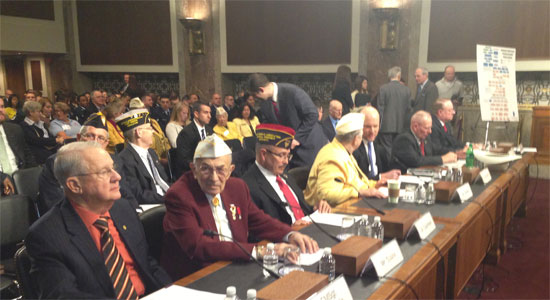
AXPOW Past National Commander & Legislative Officer Charles Susino, Jr, second from left
March 12, 2014
Messrs. Chairmen and Members of the House & Senate Veterans' Affairs Committees:
My name is Charles Susino Jr., Past National Commander of the American Ex-Prisoners of War and Chairman of the Legislative Committee. I am honored to testify before you and deeply appreciate your time in receiving the input from veteran organizations.
House Chairman Jeff Miller and Senate Chairman Bernie Sanders, we applaud your leadership in the Veterans Committees and Congress during these challenging times. Over the years our organization has watched closely your committees grapple with hard decisions aiming to provide the needs for America's veterans, their families and survivors. We deeply appreciate your help but need more.
We the military service organizations provide you the input of issues impacting our veterans and look to collectively resolve these problems. The dynamics seems to continually shift where Washington is looking to remove or reduce benefits from the veterans which will create new issues. Washington has interest in reducing the pensions, reducing health benefits and shifting costs to the veteran. Those actions are totally unacceptable.
We recognize the need to maintain a budget and control costs. Every public and private organization faces this same challenge. Our concern is the veteran's benefits always seem to the first thing on Washington's mind in a way to solve the problem. Most organizations manage their budgets through a multitude of strategies including technology, labor savings, and process improvements, just to name a few.
We challenge Washington to take a more holistic look at cost controls.
A common discussion at these hearings is the response time of veteran's claims. We have lived through the backlogs increasing and decreasing. But never has the VA achieved a level any rational person would describe as acceptable. As a national service officer, I deal with veterans and their spouses on an ongoing basis. Despite my efforts to meet with them, obtain the necessary information, and complete the forms required by the VA, I continue to see the simplest cases take absolutely too long. The Philadelphia VA is particularly bad. To name just a few examples, why should an 88 year old widow wait months and months for DIC. Why should a care giver for a 90 year old vet wait seemingly endlessly for compensation. If today was the first day we were to look at the performance of the VA in responding to our Nation's veterans we would find it unacceptable. We would find this level of service unacceptable dealing with any private business and we would find it unacceptable dealing with any other branch of the government, state or federal. So let us not take any comfort in the improvements that the VA has made over the past year, they are still performing at an unacceptable level and the focus and attention to improvement needs to be ongoing.
These VA services are necessary and are part of the cost of war, the WWII veterans are old, the Korean War veterans are old, the Vietnam veterans are getting older, and it goes on with all of our more recent veterans. Our nation has decided to be the world's peace keeper and there are costs and services required as part of that mission.
On the political side, Senator Sanders you gave us a heads up this time last year, how Washington was looking to change the COLA for social security and VA benefits from CPI to chained CPI. Although Washington was not successful reducing social security, they did include in the budget a 1% reduction in the COLA for retired veterans. Thank you for your efforts in correcting that mistake. Most important, it is telling how Washington views the veterans. Their actions set a bad precedent at the end of 2013 that when there are budget problems; one of the first areas to look for savings is on the backs of the veterans and their families. The country must remember how the veterans sacrificed. We thank you for the introduction of S.1950 and S.1982 which encompassed many of the issues that are important to veterans. With the recent action taken in modifying the COLA reduction for the military retirees, we need to maintain our resolve on the other key issues in your bill. Well documented by our letter to you and many you received from other organizations, S.1950/S.1982 contains provisions solving many of the problems our veterans face and encourage you to continue the good fight to see this Bill through. For brevity, I will not list each of its components.
As veterans, we are approached by members of the public and thanked for our service. You, as our elected representatives have taken on the challenges of our veteran community. We sincerely thank you for your service. We thank you for your service but need more. We need your commitment. We need you to serve as the nation's unwavering conscious when those in Washington want to take back from the veterans. Remain strong. We need your commitment to hear, understand, and act to solve our problems, despite the uphill battle you need to fight. So many in Washington seemingly do not understand the veterans, but you do. Thank you again.
In summary our priorities continue to be:
1. We ask these committees to work with Congress to amend the "Congressional Budget and Impoundment Control Act of 1974? to permanently authorize advance appropriations for VA health care in order to eliminate the need for an annual budget waiver against points of order. We also would like you to consider authorizing advance appropriations for all VA discretionary and mandatory accounts. For the past three decades, VA's health care system has struggled to receive sufficient, timely and predictable funding, often resulting in fewer medical services available to veterans, longer waiting lines, and an overall decline in the quality of VA care. To remedy these problems, Public Law 111-81, the "Veterans Health Care Budget Reform and Transparency Act" was developed and enacted into law in 2009 with the support of DAV and other veteran's service organizations. The law authorized advance appropriations for veteran's medical care and required the General Accountability Office (GAO) to monitor and report on VA's budget submissions in 2011, 2012 and 2013. For the past three years, the President has proposed, and Congress has approved, advance appropriations for veterans medical care programs, which has allowed VA to plan, allocate and spend its health care funding in a more efficient, effective and predictable manner.
2. However, Congress and the Administration failed to approve the FY 2013 budget and appropriations laws last year, instead passing a six-month continuing resolution to fund the government, which did not include the FY 2014 advance appropriations for VA health care. Those who gave so much for their country deserve to know they can count on getting the care they need when they need it.
3. We ask Congress to ensure full implementation of all VA Caregivers Law (P.L. 111-163) provisions. And we ask these committees to expand the law with Caregivers Expansion and Improvement Act of 2013, introduced by Sen. Sanders. (S. 851) this will extend the Caregivers Law eligibility to all veterans with a serious service-connected injury the eligibility to participate in the Department of Veterans Affairs (VA) program of comprehensive assistance to family caregivers of such veterans. (Under current law, such eligibility is limited to those veterans who incurred such an injury on or after September 11, 2001.)
4. The American Ex-Prisoners of War supports VA in its efforts to reduce / eliminate veteran homelessness. No one who has served our country should ever go without a safe, stable place to call home. VA is committed to ending Veteran homelessness by the end of 2015, but they need the help of Congress as well as the communities across America.
5. Continued improvements in the processing of disability benefits. This is not new but needs a renewed focus and energy. Provide quick turnarounds on simple matters such as DIC especially for those that are elderly and in need of the money.
6. Health benefits for veterans. Provide within the VA the necessary resources for our current needs and forecast and provide staff as the needs change over time so as not to find ourselves in a catch-up situation.
7. Health care: A significant change was made in health-care eligibility in 1986. Congress mandated VA health care for veterans with service-connected disabilities as well as other special groups of veterans, such as former prisoners of war, veterans exposed to herbicides and ionizing radiation and veterans of World War I. We repeat our request to expand the special groups to include the WWII, Korean, Vietnam, and Cold War veterans. While we recognize this is a complex issue since it would add 10's of thousands of new veterans to the existing VA facilities and potentially overwhelm a system whose primary requirement is treating service related injuries, we believe Congress should examine ways to accomplish this objective in an effective manner. In addition, please remember those warriors serving our country with tours in the Middle East as well.
Thank you for opportunity to provide our comments and to appear before you on behalf of the American Ex-Prisoners of War.
God Bless Our Troops.
God Bless America
----Remember----
The Daily Show
Get More: Daily Show Full Episodes,The Daily Show on Facebook
|
The Chicago Sun Times reports that Jon Stewart, host of The Daily Show, is outraged more people care about John Travolta mispronouncing a fellow star's name at the Oscars than about Senate Republicans blocking the veterans health care bill.
Stewart takes a few minutes on his show to lay into them for what he calls "truly shameful behavior." |
He points out that those same Republicans who claimed the measure's $21 billion (over ten years) price tag was too high had had no problem voting for unfunded Iraq spending even after billions of dollars were discovered to be unaccounted for there. The bill's sponsor, Bernie Sanders (I-VT), had said it could be paid for with war funds already allocated for Iraq and Afghanistan. The Stewart clip runs 3:21.
posted 3/6/14
|
|
Massachusetts Senators Elizabeth Warren and Edward Markey (both D-MA), Kelly Ayotte (R-N.H.), Sen. Jeanne Shaheen (D-N.H.) and Sen. Marco Rubio (R-Fla.) introduced bipartisan legislation on Feb. 27 to honor American service members designated as Prisoners of War (POW) or Missing in Action (MIA).
The Framingham Patch (framingham.patch.com) and The Springfield Republican (masslive.com) have reported that the five Senators are sponsoring the bill to establish a commemorative chair memorial on U.S. capitol grounds. |
Warren, a Massachusetts Democrat, penned the POW/MIA Commemorative Chair Act to honor the approximately 83,000 service members who are either prisoners of war or missing in action.
The bill would direct the Architect of the Capitol to place a commemorative chair bearing the logo and colors of POW/MIA service members in a prominent location at the U.S. Capitol. The chair would remain unoccupied to serve as a reminder of the ongoing challenge of accounting for America's missing service members and in recognition of their sacrifices. |
|
The five U.S. Senators marked their action by issuing a joint press release. Text follows.
FEB 27, 2014, Washington, DC � United States Senators Elizabeth Warren (D-Mass.), Kelly Ayotte (R-N.H.), Jeanne Shaheen (D-N.H.), Marco Rubio (R-Fla.) and Edward J. Markey (D-Mass.) today introduced bipartisan legislation to honor American servicemembers who are Prisoners of War (POW) or Missing in Action (MIA). The POW/MIA Commemorative Chair Act will honor these approximately 83,000 service members by establishing a permanent commemorative chair on the grounds of the United States Capitol.
"All three of my brothers served in the military, and I understand the sacrifices our service members and their families make to defend our country every single day. We must honor the contributions of our brave men and women in uniform, including those who have not made it home," said Senator Warren, "I am proud to display the POW/MIA flag outside my office, and I am pleased to support Rolling Thunder Massachusetts Chapter 1's efforts to establish a commemorative chair on the U.S. Capitol grounds." "More than 83,000 American service members remain missing or unaccounted for from past conflicts - including 49 missing service members from Vietnam and Korea from the State of New Hampshire alone," said Senator Kelly Ayotte, a member of the Senate Armed Services Committee. "Placing a commemorative POW/MIA chair on the Capitol grounds would serve as an enduring reminder of our nation's commitment to never forget our fallen and missing soldiers who made such tremendous sacrifices on behalf of our country." "Service members have made great sacrifices for our country, and the POW/MIA Commemorative Chair Act will serve as an enduring reminder of the bravery and courage of the men and women who have served," Senator Jeanne Shaheen said. "I am proud to support this commemorative act to honor the thousands of POW/MIA service members and their families, all of who have made great sacrifices for the protection and freedom of our nation," said Senator Marco Rubio, "While this can't fully express our gratitude to these brave men and women, this small act will serve as a reminder to everyone who visits the U.S. Capitol to never forget the service and sacrifices of our armed forces and their families." "Our nation's POW-MIAs should never be forgotten. This bill will help every American visiting the nation's capitol recognize the incredible sacrifice made by those brave Americans whose fate is still unknown and the courage of the families that are left behind," said Senator Edward Markey, "I appreciate the efforts of President Joe D'Entremont and the members of the Massachusetts Chapter of Rolling Thunder to ensure that our service members receive the recognition they earned through their noble service to our nation." The POW/MIA Commemorative Chair Act would direct the Architect of the Capitol to place a commemorative chair bearing the logo and colors of POW/MIA service members in a prominent location at the U.S. Capitol. This chair would remain unoccupied to serve as a reminder of the ongoing challenge of accounting for America's missing service members and in recognition of their sacrifices for our nation. The POW/MIA Commemorative Chair Act is supported by veteran's advocacy groups such as the National League of POW/MIA Families, the Veterans of Foreign Wars (VFW), the American Legion, the Military Officers Association of America (MOAA), and Rolling Thunder. posted 3/2/14 |
|
| Veterans Health Care Bill Fails in Senate |
|
Washington - CNN has reported that the Senate measure entitled "Comprehensive Veterans Health and Benefits and Military Retirement Pay Restoration Act of 2014" was defeated on the Senate floor Thursday (Feb.27). S.1982 is sponsored by Senator Bernard Sanders (I-VT), Chairman of the Senate Veterans Committee,
"On a largely party-line vote, 56 to 41, the measure couldn't reach the 60 votes it needed to clear a procedural hurdle," CNN said. The report characterized the act, designed to make numerous improvements to health and benefits services for veterans, as "a victim of the partisan gridlock and election-year acrimony that dominates the chamber." Senator Sanders's office issued a press release that read in part: 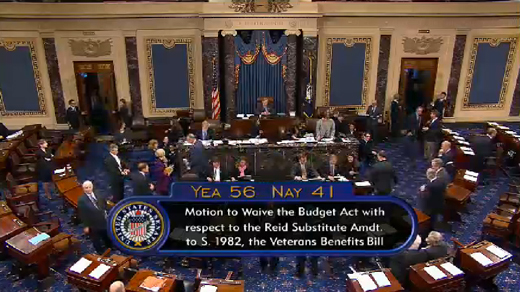 "A disappointed Sen. Bernie Sanders (I-Vt.) pledged today to continue to fight for improved benefits for veterans after Senate Republicans blocked a vote on comprehensive legislation to expand health care, education, job-training and other programs. "Republicans derailed the bill by raising a budget point of order challenging outlays for veterans. Sanders' motion to advance the bill won by a vote of 56-41, but Republicans invoked a rule that required 60 votes to proceed. "'I had hoped that at least on this issue—the need to protect and defend our veterans and their families—we could rise above the day-to-day rancor and party politics that we see here in Congress,' said Sanders, the chairman of the Senate Committee on Veterans' Affairs. "'I am going to keep fighting. I am proud that we received every Democratic vote and that two Republicans also voted with us. In the coming weeks I will be working hard to secure three additional Republican votes and I think we can do that,' Sanders added." |
| AXPOW Legislative Committee Issues Call For Action |
|
With Proposed Senate Bill S.1982: Comprehensive Veterans Health and Benefits and Military Retirement Pay Restoration Act of 2014, Senator Bernard Sanders (I-VT), Chairman of the Senate Veterans Committee, has introduced the most broad-reaching Veterans' Bill in decades. The Bill was developed by taking components from several Bills proposed over the past year or so and encompassing them within one comprehensive Bill, including provisions such as:
To view all of the sections of this Bill and see other additional information, visit www.sanders.senate.gov/download/s-1982?inline=file Show your support by contacting your Senator today! (For help on how to contact your Senator, click here.) |
Statement of AXPOW Legislative Committee on Congress's 2014 Budget Deal
|
|
Before their Holiday break, Congress passed the 2014 budget. It contains a provision reducing the cost of living adjustment [COLA] by 1% for all retired military personnel under the age of 62. Congress projects this change will save them $6 billion per year. Our position is this provision is wrong and will negatively impact current military retirees under the age of 62, future retirees, and have a negative impact on recruitment of men and women who look towards military service as a profession and career. It is also a bad precedent singling out military retirees as the only group receiving this reduction in benefits among all individuals receiving federal retirement pay. While the one per cent annual reduction on the surface may appear to be minor, the cumulative impact results in over 20% less annual compensation by age 62, or the accumulative effect of missing over two years of retirement pay in the 20 year period, major by any measure. Please write or call your Congressman to oppose this provision of the 2014 Budget. Tell them their top priority when they return from their break must be to modify the budget to remove this item and achieve the savings without penalizing the veterans or their families. It is unacceptable to penalize the veterans who gave so much for our country. PNC Charles Susino, Jr., Chair |
|
In many ways, the American prisoner of war (POW) was both a genesis and impetus for a national cemetery system. During the American Revolutionary war, casualties were often buried where they fell, on military reservations or hospital grounds, or in family plots. There are some horrific stories of treatment of POWs during that time (e.g., Col Ethan Allen of the Green Mountain Boys, himself a POW for 3 years, wrote that 11,000 POWs were killed by their British captors. It is clear that many American sailors, held as privateers, suffered harsh conditions as POW, and were joined by some other combatants held as POWs on one of three hospital ships or one of several prison ships (mostly in Brooklyn, NY but also Charleston and St. Lucia Harbors). The prisoners who died were often sent to a quick watery grave or taken nearby inland for speedy burial; identification of burial sites was haphazard if any. For the larger spectrum of land-based casualties, many church yards set up small special sites for military burials or at least memorial slabs to commemorate same including multiple named and/or unnamed casualties. Practically speaking, many casualties fell not far from home; they did not die in large volume at any given time, and since British opposition troops were from overseas, all American casualties fell on "friendly" land presumably suitable for a respectful burial. Burial circumstances during the War of 1912, the Mexican and Indian Wars as they related to POWs or distinctions between civilian to Indian prisoners versus military personnel held by enemy were murky. No formal burial/cemetery consensus was reached at any level during that time. But the Civil War rendered any prior "ad hoc" methods inadequate and inappropriate for handling the massive battlefield casualties. The Civil War had been brutal with horrific losses on both sides, and whether Union or Confederate, the dead often fell far from home, almost always in viscerally hostile enemy territory. Early on, in September 1861, War Department Orders #75 mandated the Quartermaster General assume responsibility for burial of officers and soldiers, ordered that a register of all burials be kept, and that a "headboard" be placed on each grave. First made of wood with painted or chalked data thereon, neither was durable in the elements. As deaths came faster than land titles could be established, burials often took place prior to consecration of the interment sites; public health and immediacy of identifying bodies and durability of more permanent markers gained importance in planning for designated burial spaces. For expediency, the first 14 official "national" cemeteries so designated in 1862 were primarily at already established special burial locations in Philadelphia or Annapolis, or at existing military properties or battle sites such as Gettysburg (dedicated 19 November 1863 with a short Address by President Lincoln) or Antietam, or military locales like Forts Scott or Leavenworth. One of the oldest and most beautiful of these was and is at the U.S. Soldiers and Sailors (later Airmen's', and now Armed Forces Retirement) Home in Washington, D.C. 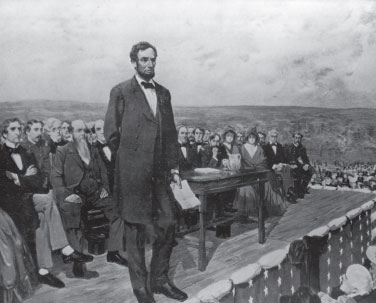
Lincoln at Gettysburg
In July 1862, via legislation primarily purposed for other things, Congress had empowered President Abraham Lincoln to purchase cemetery grounds and have them securely enclosed. However, throughout the war there was no lasting or official system to document missing or dead soldiers. Civilian vendors had a version of a dog-tag available, but few soldiers bought and wore one. By 1863, according to esteemed author and POW expert Robert C. Doyle, and for a variety of reasons, treatment of POWs on both sides took a turn for the worse. Notwithstanding all of the explosive political rhetoric on both sides, after the cessation of further POW exchanges by General Grant in 1864, more POWs died, exacerbating the burial crisis. A different sort of problem arose from the sheer masses of Civil War POWs on both sides. By the end of the war, 37 major POW camps were established in the North and another 38 POW camps in the South. Certainly some of the POWs captured and imprisoned died of wounds from the battlefield, but increasingly, the high mortality rate derived from lack of sanitation and disease along with crowding and other inherent conditions. It was thought that eventually some 56,000 died in POWs camps both North and South. Something had to be done to address this multi-faceted crisis. One horrific example was the open-aired, filthy POW camp at Fort Sumter, GA (near Americus, often called Andersonville), where from February 1864 until liberation in May 1865, some 45,000 enlisted men and some women were POWs, of whom 13,000 died. While some died of war wounds, and a few from in-prison assaults, these deaths were primarily of starvation, malnutrition, diarrhea and communicable diseases. Thus the already existent need to identify bodies and bury them properly developed into the inexorable problem of doing so expeditiously and in such manner as to avert further health crises. In the North, the frigid climate took its toll. (E.g., 1864-5, the period September to February, 1,848 POWs died at the Union POW Camp in Elmira, NY). Significant action to resolve the dilemma was generated by a single woman, Clara Barton, who had achieved fame (and accordingly, some clout) as a nurse on the battlefield. She had been receiving letters from families trying to find their missing loved ones. In June 1865, she heard from a young former POW at Andersonville, a clerk named Dorence Atwater who has been paroled to work at the hospital there, who had diligently maintained his own set of death records. |

Arlington National Cemetery
Thus the already existent need to identify bodies and bury them properly developed into the inexorable problem of doing so expeditiously and in such manner as to avert further health crises. In the North, the frigid climate took its toll. (E.g., 1864-5, the period September to February, 1,848 POWs died at the Union POW Camp in Elmira, NY). Significant action to resolve the dilemma was generated by a single woman, Clara Barton, who had achieved fame (and accordingly, some clout) as a nurse on the battlefield. She had been receiving letters from families trying to find their missing loved ones. In June 1865, she heard from a young former POW at Andersonville, a clerk named Dorence Atwater who has been paroled to work at the hospital there, who had diligently maintained his own set of death records. 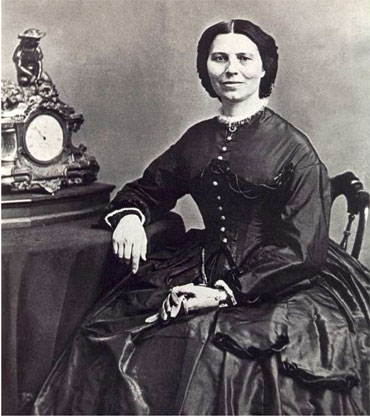
Clara Barton
Barton contacted Secretary of War Stanton and she and Atwater accompanied the Army expedition to Andersonville to identify the graves, hauntingly distinctive due to the lack of coffins and the close proximity between headstones still visible, tilting in the red Georgia clay. Many headboards were prepared and letters sent to families about their loved ones. Then Barton took the program back to Washington and set up the Missing Soldier's Office (1865-1867), during which time she identified more than 30,000 MIA/POWs including nearly 13,000 who had died and were buried at Andersonville in a cemetery consecrated for that purpose. In the meantime, spaces were becoming scarce at existing burial locations, so Quartermaster Montgomery Meigs recommended buying property at the mansion of Robert E. Lee and his wife Mary Anne Randolph Custis, a granddaughter of George and Martha Washington. In May 1861, after Virginia seceded, the Union Army occupied the property, and the grounds were designated as a burial grounds for the war dead. The first Arlington burial took place in May 1864, and soon thereafter, Secretary of War Stanton designated the mansion and 200 acres of the land as a cemetery. Immediately after the surrender by Lee to Grant in April 1865, the Quartermaster Department undertook a nearly impossible program, called the Federal Reburial Program, to recover, identify and bury all Union soldiers not otherwise claimed by family. For a number of reasons both on land and sea, this simply was not fully efficacious and the program ended in 1870, with 299,606 Union soldiers and officers having been located and re-interred in 73 national cemeteries, estimated at a sad 58% success rate. Additional national cemeteries were set up at various former POW sites including Andersonville (GA), Florence (SC), Salisbury (NC) and Woodland (NY). A number of other locales in which there had been POW prisons endeavored on their own to facilitate suitable respectful burials, often in common graves. Instances include those 1,616 Confederate POWs who died at Camp Morton (1862-1865) in Indianapolis, IN, in a common grave which was moved eventually in 1931 to Crown Hill Cemetery. Some of these sites have since undertaken more fitting re-interments, and many local volunteers have endeavored to identify the deceased soldiers. In Indianapolis, two policemen prepared bronze plaques with the names of the Southerners who died at Camp Morton, re-dedicated in a ceremony in October 3, 1993 that included representatives (and actual soil samples) from the 14 former Confederate states and territories. Other examples of new burial sites were the old cemetery at Fort Columbus on Governors Island off the tip of NY City, the POW hospital at Beaufort, SC, Point Lookout in Baltimore, MD, and Johnson's Island in Sadusky, OH. After the Civil War, Congress passed amendments to the National Cemetery Act of 1867 to expand the coverage for veterans, and cemeteries were established far beyond Civil War battlefields and POW camp sites. New locations included Ft. McPherson (NE), Santa Fe (NM) and San Francisco (CA) where the cemetery on the grounds of the Presidio became the first on the West Coast. As they expanded, there were also improvements to the planning and appearance of each, one of the first major changes being replacing wooden headboards with marble headstones. 
posted 10/10/13 |
2013 National POW/MIA Recognition Day
Friday, September 20, 2013 Defense POW/Missing Personnel Office
|
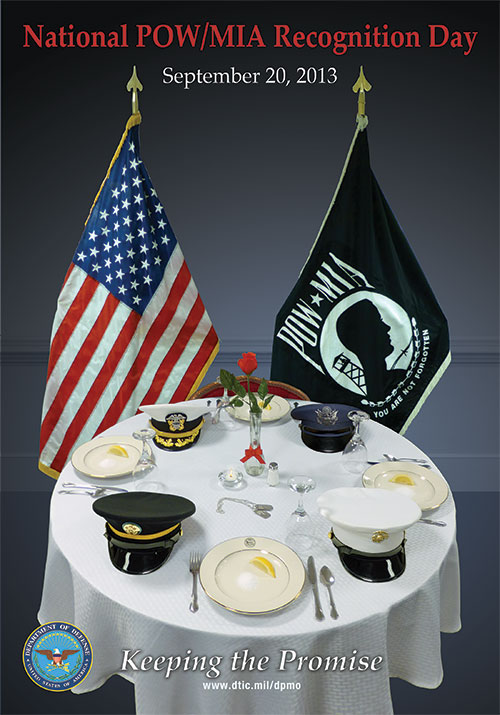 |
| National, State and Local Events Mark National POW/MIA Recognition Day |
|
Washington, DC � Observances of National POW/MIA Recognition Day will be held across the country this Friday and over the weekend on military installations, ships at sea, state capitols, schools and veterans' facilities.
The Recognition Day observance is one of six days throughout the year that Congress has mandated the flying of the National League of Families' POW/MIA flag. Others are Armed Forces Day, Memorial Day, Flag Day, Independence Day and Veterans Day. The readily identified POW/MIA flag will fly at major military installations, national cemeteries, all post offices, VA medical facilities, the World War II Memorial, Korean War Veterans Memorial, the Vietnam Veterans Memorial, the official offices of the secretaries of state, defense and veterans affairs, the director of the selective service system and the White House. A Pentagon ceremony for National POW/MIA Recognition Day will feature troops from each of the military services. Andersonville National Historic Site's remembrance this year will feature a prisoner of war from the current generation, Iraq war veteran Shoshana Johnson. Johnson's convoy was ambushed during Operation Iraqi Freedom. She was wounded and captured along with several other members of her company. House raids conducted by U.S. Marines resulted in the successful rescue of Johnson and her fellows. Johnson's military decorations include the Bronze Star, Purple Heart, and the Prisoner of War Medals. She will share her story Friday from 10 a.m. to Noon and from 1 to 3 p.m. EDT at Andersonville National Historic Site. She will also be the featured guest during a special program at the Rylander Theater in Americus, GA, on Thursday evening. Around the country, the observance of National POW/MIA Recognition Day is also marked with a growing number of state and local ceremonies. Local papers and television can provide details for those wishing to take part. National and local motorcycle clubs across the country, including Rolling Thunder, traditionally mark the remembrance in their own way, scheduling membership rides that create an impressive spectacle over the observance weekend, often in conjunction with locally scheduled events. |
|
There are fantastic movies of historic focus, some of which have abundant embedded truth. Through one of those relatively recent documentaries, The Real Inglorious Bastards, seen on The History Channel, many have already met Fred Mayer. Or for a reader of Gerald Schwab's OSS Agents in Hitler's Heartland: Destination Innsbruck or the award-winning Patrick O'Donnell's They Dared Return, this will be merely a reintroduction to Fred Mayer and some of his extraordinary friends. These and other news media were resources for this article, and it may be stipulated that Mayer's life story is way better than fiction! Frederick (Fred) Mayer, born in 1921 in Freiburg, Breisgau, Baden-W�rttemberg, Germany, was a gifted teen athlete, a youngster of firm beliefs, a risk-taker, innovative thinker, and a skilled tinkerer. Able to fix all sorts of things, Fred worked after high school as an apprentice diesel mechanic for Ford Motor Co. His father, Heinrich, had been awarded the Iron Cross Second Class as a LT in the Imperial German Army in WWI, for gallantry during the Battle of Verdun, and dared hope this might help protect his Jewish family. But anti-Semitic Nazi winds began to blow more fiercely, and in 1938, at the insistence of Heinrich's wife, and after a two year fight to get visas, the Mayerses fled Hitler's Germany with the clothes on their backs to NY. The entire family worked at myriad jobs in Brooklyn. Feeling a patriotic debt owed to his new country, on December 8, 1941, Fred applied but was rejected by the draft board as an "enemy alien." Reflecting lifelong persistence, Fred pled to take the place of his brother in college, was accepted at age 20 in the U.S. Army, and shipped off for boot camp at Ft. Rucker, AL and beyond. From the outset, Mayer demonstrated what they sometimes call in the intelligence trade "an instinctual adaptability." In July 1943, in the blazing training heat of Arizona with the Eighty-First Infantry Division, Mayer drew special attention as he led field exercises for the Wildcat Rangers, an elite reconnaissance unit. In sum, having worked exquisitely and freely behind the pretend "enemy" lines, Mayer opted to take not only a few soldiers as "prisoners" (as was the exercise's goal), but to capture the entire HQ including the Brigadier General heading the outfit. The General was duly chagrined but sufficiently impressed that within a few weeks, a letter arrived for Mayer to report to the HQ in Washington of the Office of Strategic Services (OSS). 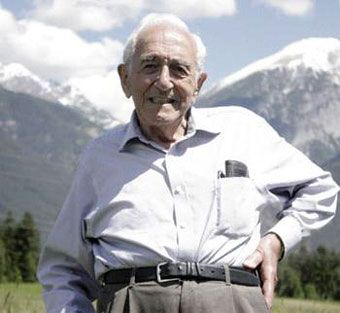
At the primary OSS training site, the 400 acre Bethesda, MD Congressional Country Club, new recruits were given physical and psychological aptitude-testing and then, via a lot of attention-getting live ammo, booby-trap tampering, stiletto sticking, grenade spinning and sniper training, swiftly crafted into spies, saboteurs and similar sundry operators. Mayer met his own particular comrades, a mixed-bag group of what was tagged the German Occupational Group (GOG) ranging from former Luftwaffe pilots to Jewish death camp escapees, Polish deserters, a world class athlete and a former convict. Mayer loved the group and their purpose: to penetrate enemy lines and strike at the heart of Nazi Germany via what became the genesis of American special ops. Mayer's all German-speaking group of 30 thrived at learning many things (e.g., sniping, knifing, demolition, infiltration). Five of the men were truly a special affinity group (Mayer, Wynberg, Steinitz, Gerbner and Rosenthal): all European Jew refugees and multi-linguists, with deep common bonds and beliefs. Mayer was described in an OSS assessment report as "aggressive, husky, resourceful and a natural leader who has a remarkable ability to improvise in special situations." They went to Ft. Belvoir to learn "driving" skills; then to Ft. Benning for paratrooper qualification; then to Catalina Island, CA for survival/amphibious warfare. The five new friends and comrades were soon ready for "real action." In early summer 1944, the OG's embarked on a troop ship for Europe which dropped them off in the wrong location, starting several months wandering in North Africa with considerable on-the-job learning along the way. Eventually contacting the OSS office in Italy, they were ordered to Bari where recruitment of infiltrating agents was not going well. Several Fall 1944 efforts to use German POWs had been jinxed by legalities/practicalities Mayer and his group were charged to sort through the POWs and see with whom they could pair up to infiltrate behind lines. In January 1945, to test Mayer's credibility, dressed as a German officer, entered Allied POW Camp 209 near Naples. |
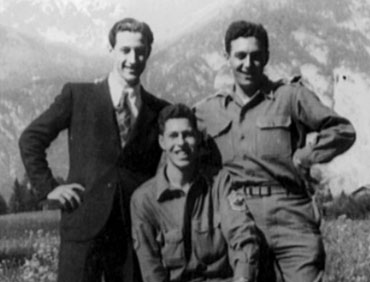
Mayer, Wynberg and Weber (wearing the suit) of the GOG (German Occupational Group) posing in the mountains in 1945. Weber was a deserting Wehrmacht officer.
The story of those days in the POW camp is legendary: not only did Mayer "pass" as a German POW, but he found an extraordinary skilled, brilliant real German POW (former Austrian Wehrmacht officer and lawyer Franz Weber) to infiltrate with him. Operation Greenup, charged with obtaining wide-ranging pivotal intel from Innsbruck, and virtually suicidal in nature, commenced.
Multi-faceted Operation Greenup in February 1945 asked Mayer, Wynberg and Weber, to scout the heavily fortified Austrian Alpine Redoubt area. Parachuting onto a frozen glacier lake but losing their ski package, they made their way on foot to Weber's family home. Mayer posed as an elite106th Alpine German Army officer, staying at and radioing back data from the Innsbruck officer's barracks. His intel gathering was extraordinary, ranging from the exact location of Hitler's Berlin bunker to details permitting destruction by the US Air Force of 25 of Nazi trains. Mayer developed local agents and had Weber's sister, a nurse, bandage his head to support his disguise in a particularly audacious event to put him into an intel-rich rest area for convalescing soldiers. The result: engineering details, train schedules and staggering insights. Three months later Mayer posing in beret and civies as a French electrician fleeing the advancing Soviet forces, worked in a German aircraft plant until one of his black market contacts turned him in to the Gestapo as a spy. During his torture-filled captivity, he initially spoke only German but eventually said he was American working alone while protecting his extraordinary harvest of detailed, quality data of industrial and strategic nature. Another German-American OSS agent, fellow POW Matull, was also separately tortured by the Gestapo, and when shown a photo of Mayer, said he recognized him but described him as a "big shot," a ploy that worked well on several levels (e.g., Mayer was reputed to be so "high up" that he should be interrogated by someone of equally high stature. Mayer was taken to Franz Hofer, a local official who had seen the handwriting on the wall and wanted to surrender to Americans rather than Soviets. Hofer introduced Mayer to his wife and the German ambassador to Mussolini's government, Rahn. It was Rahn who personally took Mayer's report that he was "captured but OK" to Allen Dulles, the OSS man in Bern. On May 3, 1945, Major Bland West, an intelligence officer with the American 103rd Infantry Division of the Seventh Army entered Innsbruck and was met by a car with a white sheet flying. A beaten, bruised Mayer, the American Jewish German immigrant, took West to accept the German surrender of the city. Former Director of the Central Intelligence Agency (CIA), William J. Casey, called Operation Greenup, "By far the most successful of OSS operations mounted from Bari." Mayer was awarded the Purple Heart and Legion of Merit. Then, as now, many thought he deserved the Medal of Honor. After being discharged from the OSS in 1945, Mayer worked at General Motors and as a power plant supervisor for Voice of America, during which time he traveled the world. Mayer stayed in touch with many of his OSS friends, particularly the special five. In 1990, the Austrian government awarded him the Tyrolean Order of the Eagle in Gold. In mid-April 2013, Senator Jay Rockefeller (D-WV) introduced information into the Congressional Record relating to Mayer, and wrote to President Obama to further recognize Mayer's service to the country. Mayer, at 92, is a long way from his original Black Forest home. But he still exhibits the handshake of a man who mows his own lawn and chops wood on a regular basis at his relatively quiet WV (Jefferson County) home. It's a split-level he built himself for his family in the 1970's. He volunteers every Monday for Meals on Wheels. His best friend is still Hans Wynberg. 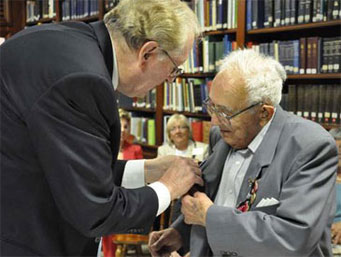
This past May, Fred Mayer attended "The Real Inglorious Bastards (invitation-only) Screening" at the 7th Annual GI Film Festival in Arlington, VA, followed by a Congressional Reception at the U.S. Capitol Building. Senator Jay Rockefeller presented him with the numerous medals he had not received during wartime because of the secrecy of his service (including the Prisoner of War Medal, awarded for honorable service while being held in enemy hands; Legion of Merit; Good Conduct Medal; American Campaign Medal; European-African-Middle Eastern Campaign Medal with three Bronze Star devices; World War II Victory Medal; World War II Honorable Service Lapel Button; and Parachutist Badge.)
posted 9/9/13 |
MIA Search Facility Expanded
|
|
Some 83,000 service members still remain missing from the Pacific theaters of WWII, Korea and Vietnam. The Joint POW/MIA Accounting Command (JPAC), with primary headquarters in Hawaii, sends teams out across the world to search out, retrieve and identify remains of missing American service personnel. Hawaii is both an idyllic and practical location for the work, as it is nearer many of the search sites in the Pacific theaters of WWII, Korea and Vietnam, where retrieval is rendered more difficult, as the soil is acidic and remains deteriorate quickly, often leaving only teeth. To further its effort, JPAC HQ is building a new 136,000 square foot structure in Hawaii to support the work of its 500 member staff. But Joint Base Pearl Harbor-Hickam (in the U.S. Pacific Command) is remote from mainstream CONUS families and workers. And JPAC is also charged with helping MIA's families. Facebook, Twitter and other social media have facilitated the closeness for families to the searches for loved ones. Collateral to the MIA issue, after September 11, 2001, it was clear that a mainland forensics laboratory was necessary to react quickly in time of tragedy or terrorist strikes. These exigencies served as immediate impetus for expanding JPAC capabilities. After a long search and two years of construction, JPAC has opened an impressive new $5 million satellite forensics laboratory at Offutt Air Force Base, Nebraska. Sophisticated equipment and myriad long-wheeled tables reside in the stark, white-tiled, 27,000 square foot forensics lab located in a former bomber plant. For novelist Patricia Cornwell aficionados, the facility is a huge, fascinating magnification of the fictional Dr. Kay Scarpetta's forensic crime lab. |
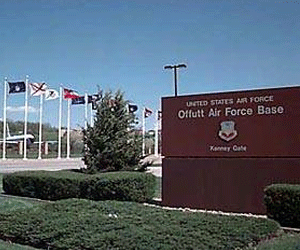
Using historical, anatomical and dental analysis, DNA sampling and electronic imaging decides, JPAC currently identifies the remains of about 80 MIA's annually with an eye to the Congressional mandated goal of identifying 200 unaccounted for remains per year by 2015. Additional manpower is going to the field and the labs will partner with university researchers.
With 14 people now at work at Offutt, a work force that will increase to 50 by 2016, a glance at the internet sites advertising for myriad specialists (e.g., anthropologists, archaeologists, forensic odontologists and support personnel) reflects a window on the range of needs and capabilities for the satellite center. And MIA families are welcomed. 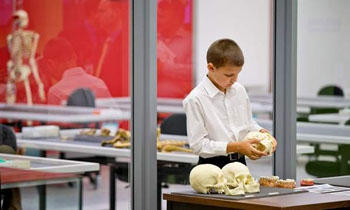 The young boy examining skulls on one of the long tables at the opening event at Offutt laboratory annex is Bryan Stuckenschmidt, age 9, of Omaha. His great uncle, Spc. Don Grella, and three crewmates went down with their helicopter in Vietnam on December 28, 1965.
posted 8/4/13 |
Now Hear This: All Hands on Deck
|
|
Over 55,000 hands served on the USS Intrepid over its 31 years of service. If you're one of them, you're being invited back for a visit this summer for what promises to be quite a party. The Intrepid Sea, Air & Space Museum in New York, where the ship is now permanently moored, is holding a Homecoming Weekend party August 16 - 18 for all former crew members. The event is part of the commemoration of the 70th anniversary of the USS Intrepid's commissioning. The Homecoming Weekend will feature programs and events specifically tailored for former crew members and their families. Most of these will be open to the public as well. Entrance to the museum will be free of charge for former crew members and their family members over the homecoming weekend. There will be public guided tours of the ship and behind-the-scenes curator-led tours of the museum's collection storage facility. For some former crew members, this will be the first time they have been aboard their beloved ship since the completion of their service. The USS Intrepid was the third Essex-class aircraft carrier, one of 24 such vessels, built during World War II for the United States Navy. She was the fourth US Navy ship to bear the Intrepid name. (See box below.) And she was destined to become one of the most successful and stalwart ships in US history. Commissioned August 16, 1943, the Intrepid was built to carry a crew of 2,600 officers and enlisted men. (During WW II, the crew swelled to 3,300 - 3,500) She was 820 feet long and with a displacement of 36,380 tons full load. She was capable of cruising at 33 knots (61 km/h) with a range of 20,000 nautical miles. Decommissioned shortly after the war's end, the Intrepid was then modernized and recommissioned in the early 1950s as an attack carrier, and eventually became an antisubmarine carrier.
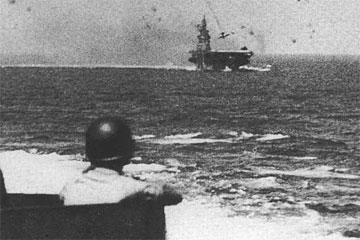 In WW II, the Intrepid absorbed five kamikaze attacks, yet wouldn't sink. (Note plane in photo is about to hit deck.) The Japanaese nicknamed the carrier "the Ghost Ship." The first fourteen Essex class carriers had wood flight decks. After the kamikaze attacks attacks, the rest got decks of steel.
During World War II, Intrepid took part in several campaigns in the Pacific Theater, most notably The Battle of Leyte Gulf (considered the largest naval battle of the war and possibly in history). Twenty years later she served three tours of duty off Vietnam. After that she conducted submarine surveillance in the North Atlantic during the Cold War. The Four Intrepids of US Naval History
• 1798: an armed ketch captured as a prize by the US Navy in 1803. Commodore Stephen Decatur used it to enter Tripoli harbor and destroy the captured USS Philadelphia • 1874: an experimental steam torpedo ram commissioned 31 July 1874 and sold 9 May 1892 • 1904: a training and receiving ship launched 8 October 1904 and sold 20 December 1921 • 1943: an Essex class aircraft carrier, now serving as museum and National Historic Landmark |
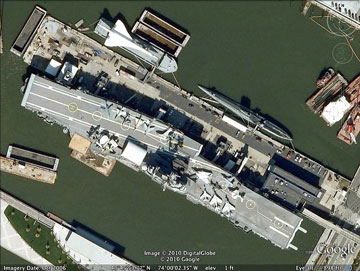
The Intrepid Sea, Air & Space Museum includes the Intrepid, the space shuttle Enterprise, the guided missile submarine Growler and 27 aircraft including the A-12 Blackbird, world's fastest plane, and the British Airways Concorde, world's fastest commercial aircraft.
Back in the Pacific, The Intrepid served as one of the primary recovery vessels for NASA during the Mercury and Gemini Space Missions, retrieving astronauts Scott Carpenter and Gus Grissom after their respective Earth orbits and splashdowns. The Intrepid was decommissioned again in 1974 and ultimately, in 1982, became the foundation of The Intrepid Sea, Air & Space Museum, where today it serves as a museum ship and national historic landmark. Reunion coordinator Ralph Slane expects that between 350 and 400 former crew members will be on board along with their families over the Homecoming weekend. "Many will be there to share their own personal recollections and stories first-hand with the public," Slane added. "We'll have some 50 or more World War II veterans along with 15 to 20 �plank owners,' members of the original crew serving on the ship when it first launched." Guests can experience areas of the ship including the Flight Deck, Hangar Deck, fo'c'sle (commonly known as the anchor chain room), new multimedia presentations and exhibit collections, interactive educational stations and a state-of-the-art public pier.
Attention All Hands: If You Plan on Coming ...
Former crew members or family members planning on visiting The Intrepid Museum over Home-coming Weekend, Aug. 16 -18, are encouraged to register online. Click here for form. Contact Carly Goettel, Director of Institutional Advancement, at cgoettel@intrepidmuseum.org or (646) 381-5279 with any questions. Crew members are invited to share photos of themselves during their time aboard. These photos will make up our former crew member website album and will be featured at the museum during Homecoming Weekend. Click here to learn how to submit photos. The USS Intrepid Former Crew Members Association will host a gala New York harbor dinner cruise on August 16, in addition to other off-site activities taking place throughout the weekend. Former crew members wishing to take part should contact Ralph Slane at ralphwslane@aol.com or (917) 301-3666. Visitors to The Intrepid Sea, Air & Space Museum also can experience the 12,240 square-foot interactive Exploreum—which contains a variety of hands-on exhibits. It teaches guests about the different properties of the sea, air, space and living at sea as each relates to the ship Intrepid. In The Exploreum, guests can experience a flight simulator, transmit messages using Morse code, sit on the bunk of a crewmember, learn how The Intrepid turned salt water into fresh water and perform various tasks while wearing space gloves. posted 6/20/13 |
| Update: Taliban Offers to Swap American POW for Five Gitmo Detainees |
|
KABUL, Afghanistan � The Taliban have Proposed exchanging the only known American prisoner of war from the conflict in Afghanistan, U.S. Army Sgt. Bowe Bergdahl, for five senior operatives held at Guantanamo Bay. The offer was reportedly made by senior Taliban spokesman Shaheen Suhail during an exclusive phone interview with The Associated Press from his newly opened political office in Doha, the capital of Qatar.
With peace talks threatening to break out, envoys for the insurgent movement suggested the release of Sergeant Bowe Bergdahl could serve as a confidence building measure with the US, according to The Telegraph (UK). Sgt. Bergdahl, 27, from Hailey, Idaho, has been held captive since 2009 after going missing from his base in Afghanistan. It is believed he is being held in Pakistan. See "Bring Bowe Home" posted previously on this site. |
Update: Hashimoto's Planned US Trip Cancelled in Wake of Criticism. |
|
OSAKA, Japan � Embattled Osaka Mayor Toru Hashimoto announced he was canceling a planned mid-June visit to the United States following backlash against his public remarks about Japan's wartime use of "comfort women."
The Ashai Shimbun and other Japanese newspapers reported the cancellation may have been done to avoid controversy that could have dogged his trip and created further friction in the United States. (See story immediately below.) The Osaka mayor had planned visits to San Francisco and New York for meetings with their mayors as well as visits with local companies. |
Mayor Of Osaka's Views On World War II Sex Slavery Practices Draw Condemnation In Japan And US
|
|
Toru Hashimoto had been riding a wave of success as a rising political force in Japan. But the young, blunt-speaking mayor of Japan's third largest city and founder of the country's nationalist-leaning Japan Restoration Party recently found himself in hot water, forced to explain earlier remarks about Japan's wartime use of "comfort women." When Hashimoto appeared to defend the practice of subjecting women from across the Asian peninsula to brutal conditions working as prostitutes in Japanese military brothels, often after having been tricked or coerced into service, Criticism came from all quarters ranging from victims' groups to Japanese Prime Minister Abe. Hashimoto's travails came on the heels of a progressive collapse in the influence of his party, which just six months ago seemed poised to become Japan's major opposition party, ahead of scheduled parliamentary elections this summer. The Financial Times reported on May 27, "Some in Japan see Mr. Hashimoto's provocations as a deliberate attempt to rekindle enthusiasm for his cause � an attempt that went too far and backfired. A lawyer who first gained public attention as a sharp-tongued television commentator, he has built his career on a rare and often bracing contrarianism and may have overestimated the public's appetite for attacks on what he sees as suffocating political correctness." Click here to see �Comfort women' gaffe wounds Osaka mayor As Hashimoto scrambles to regain his footing he faces backlash in the US as well. His comments, which he has alternatively tried to apologize for and defend, were rebuked by the U.S. Department of State, the U.N., and human rights and private advocacy groups among others. |
Emily M. Murase, Executive Director of San Francisco's Department on the Status of Women, and a board member of the San Francisco-Osaka Sister City Association, released a statement May 20 that said, in part: "I stand together with women's groups in Japan and around the world to urge Mayor Hashimoto to take immediate steps to repair the damage resulting from his inflammatory statement, and to publicly recognize the tremendous human suffering and human rights violations of the wartime sex slavery system against women." The Global Alliance for Preserving the History of WW II in Asia has called for the city of San Francisco where Mr. Hashimoto is scheduled to make an official visit early June, to withdraw the invitation. The group (see their website here), which has worked closely with the American Ex-Prisoners of War association in the past, has issued a press release declaring, "We strongly urge the City of San Francisco to immediately withdraw the invitation and also rescind the relationship of sister cities between Osaka and San Francisco to reflect our collective displeasure and rejection of the history deniers and their inhumane mindset." (Press release reproduced here.) San Francisco's sister city relationship with Osaka is the nation's oldest, dating back to 1957. The Alliance is urging people to contact San Francisco Mayor Edwin Lee to express their displeasure and urge the visit's cancellation. It even provides email (mayoredwinlee@sfgov.org) and phone (415 554-6141) contact information for the Mayor's office. |
The Tale of Peter Jones Knapp, from Birth to Grave (eventually)
|

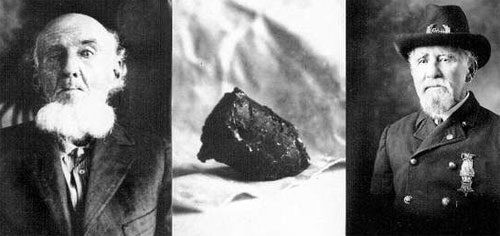
|
There is a Hebrew word for the period between death and burial: "aninut." Col. Peter Jones Knapp's exceeded the span of his lifetime, which itself exceeded the traditional three score and ten, by eighty-eight years. He wasn't Jewish, but still, it has to be some kind of record. Knapp was a Civil War veteran and survivor of several Confederate prison camps, including Andersonville. He was born June 2, 1842, in Sandusky, Ohio, and died Apr. 13, 1924 in Kelso, Washington. He and his wife were, in the fullness of time, finally laid to rest, on April 13, 2012, at the Willamette [OR] National Cemetery, near Portland. It's a long story. A nineteen year-old Knapp enlisted with Company H, 5th Infantry, Iowa Volunteers, in July 1861, and followed General Ulysses Grant down the Mississippi to Vicksburg. After months of battle, he came down with typhoid. Too ill to travel, he and other men were left in an abandoned building without medical attention for three weeks. Knapp witnessed the surrender of Memphis and survived the Battle of Iuka (MO), where his regiment lost more men in 80 minutes than any other regiment lost in any other engagement of the entire war. He also lived through the battles at Shiloh, Vicksburg and Missionary Ridge. Military historians said Missionary Ridge was "the war's most notable example of a frontal assault succeeding against entrenched defenders holding high ground." Of the 56,000 Northern soldiers engaged in the battles for Chattanooga (Orchard Knob, Lookout Mountain, and Missionary Ridge) 5,824 were killed, 2,160 wounded and 300 missing, including some taken prisoner by the Confederates. Knapp became one of the prisoners. He was held first at Andersonville and later transferred to prisons at Charleston, Libby and Belle Island. Eventually he escaped with a group of others. Starved, without even a shirt on his back, and almost blind from sickness, he had to be led as they managed their way back to the Union lines. After the Civil War, Knapp re-enlisted and served 15 months in the Indian War. In 1870 he married Georgianna Eliza Pearson at Muskegon, Mich. Their marriage would endure for over 53 years. The Knapps headed west in 1887, resettling in Kelso in Washington State. In the early 1890s they adopted a daughter, named Minnie Mae, their only child. Knapp ran a saw mill, developed a coal mine in Cowlitz County with one of his brothers and was a police judge. He was elected justice of the peace after his mill retirement, and was commandant of three different posts of the Grand Army of the Republic (GAR), where he was in charge of indigent veterans' benefits for years. On April 13, 1924, just shy of his 82nd birthday, having survived two wars, Peter Jones Knapp succumbed to the frailties of age and passed away in his wife's arms. Noted the Kelso Kelsonian in its obituary, "Mr. Knapp was the last of thirteen children and is survived by his wife and a daughter, Mrs. May Elliott. Funeral services were conducted from the Kelso Presbyterian church, Wednesday, April 16, with final services at the Portland Crematorium." No mention was made of interment. What transpired after Knapp's death and the circumstances that led to an extraordinary burial service almost a century later, with full military honors and complete with Civil War re-enactors, historians, press, civilian and military brass and 300 relatives and friends he never met, is another story in itself—several stories as it turns out. First is the story of a chance encounter with a Confederate sharpshooter during the Vicksburg campaign. Knapp, patrolling with two other soldiers, spotted the sharpshooter behind a large piece of metal boilerplate and shot him in the eye through the peephole he was peering out of. An extraordinary shot. Thinking it had inflicted a mortal wound, the band moved on with their patrol. This proved a miscalculation, and the episode with the sharpshooter, one Willis Meadows of the Alabama Volunteer Infantry, was to gain national press attention many years later (1921). It even wound up memorialized by Ripley's Believe it or Not. (See sidebar, right.) The story about the story might have been a transient sensation, but various papers kept it alive, revisiting it periodically. A Central Point, OR, resident, Henry Kilburn, brought it to the local newspaper editor's attention in 1950. He had in his possession photos of the two protagonists, another of the bullet Meadows had expelled and Knapp's hand-written diary. Henry Kilburn was the biological brother of the Knapps' adopted daughter. It was Mae Kilburn Knapp who, on a visit to Oregon in 1950, had given her brother the story, the diary and the photographs that he brought to the Central Point editor. |
In 2009, Bill Miller, a reporter for the Medford [OR] Mail Tribune, breathed life into the story yet again. He chanced upon the 1950 Central Point article quite by accident while looking through that (by then long-defunct) newspaper's microfilm records in connection with a different story. After some additional research, Miller and his editors decided the Knapp/Meadows story was worth yet another retelling. Bullet Didn't Kill; Story Wouldn't Die
(Excerpted from:"'Coughs Up Bullet': The unlikely sequel to a Civil War mystery" by Bill Miller, Medford [OR] Mail Tribune, 2009)
For 58 years, the bullet that took the right eye of Confederate soldier Willis Meadows in 1863 at the siege of Vicksburg was lodged near his brain. It reappeared unexpectedly in 1921 when Meadows was stricken with a violent coughing spell sitting at his kitchen table in rural Alabama. The spasms became so severe, the 78-year old couldn't breathe. Just when he thought it was his time to die, something flew from his mouth, bounced on the wooden table and tumbled to a stop. Willis Meadows had been 19 in the spring of 1862 when he joined his brothers and cousins in Company G of the 37th Alabama Volunteer Infantry. In the summer of 1863, his company was defending the city of Vicksburg from the Union assault. On July 1, just outside of town, sharpshooter Meadows was firing his rifle through a peephole in a piece of iron boilerplate at Union troops. Peter Knapp and three other Union soldiers were approaching from the east with orders to kill any Confederate snipers they came across. Knapp spotted Meadows and took aim at the peephole. Meadows fell, blood running from his right eye, apparently dead. The wound proved not mortal, however. Meadows was found and brought to Union surgeons who probed for the bullet but were unable to find it, and didn't feel it was safe to perform an operation. Meadows was put on board a POW ship and transported to a Union hospital. Later, he was paroled to a Confederate hospital, where he spent the rest of the war as a patient and sometime nurse's aide. After the war, he returned to his Alabama farm, just east of the Georgia state line. He married, but had no children and probably would have died in obscurity but for one violent coughing spell. "Coughs Up Bullet" became a national newspaper story. A Ripley's Believe It or Not cartoon was published in 42 countries and 17 languages. Among those whose attention the story caught was Peter Knapp. He came to believe that he was the Union soldier who had fired that bullet. Knapp contacted Meadows and when they compared notes, they realized it was true. The aging veterans spent their last few years as friends, exchanging photographs and wishing each other good health. Knapp died in 1924. The date of Meadows's death is unknown. Their story never did die. It had what newspaper people call "legs." Eventually Miller's story caught the eye of Peter Knapp's great-great-great-niece by marriage. Alice Knapp of Nehalem, OR, found Miller's piece online in 2011. Her family's self-appointed genealogist, she had been on Knapp's trail for some time, looking for evidence that could point her to the location of her Civil War veteran ancestor's gravesite.
The newspaper sent her what information it had, including Peter's obituary, which provided the clue she had been looking for. As Miller recounts, "The obituary said Peter's body would be taken to the Portland Crematorium. Alice discovered that the crematorium was still in business, but now operating under the name of Wilhelm's Portland Memorial Funeral Home. "She called and asked whether Wilhelm's had Peter's remains, and the unexpected answer was yes. She was even more surprised to hear that Georgianna was there, too." (She had died in 1930.) Alice Knapp put all of this information together and contacted veterans' advocate Debbie Peevyhouse of the California Medal of Honor Project, the Oregon Military Department and others to secure a proper resting place for the ashes. The rest, as they say, is history. |
- Peter Knapp Obituary - The Kelsonian (Kelso, WA), 4/16/24
- A 58 Year Ood Bullet - Ripley's Believe it or Not, 10/12/32
- 'Coughs Up Bullet': The unlikely sequel to a Civil War mystery - Medford Mail Tribune, 10/11/09
- Civil War vet gets long-delayed tribute - Medford Mail Tribune, 4/14/12
- Andersonville POW Veteran Finally Rests in Peace - Ex-POW Bulletin, July/Aug '12, p.18
Statement of Charles Susino, Jr., National Commander of the American Ex-Prisoners of War Before the Committees on Veterans' Affairs U.S. Senate/U.S. House of Representatives, February 28, 2013. |

AXPOW National Commander Charles Susino, Jr. Messrs. Chairmen and Members of the Veterans' Affairs of the Veterans' Affairs Committees: My name is Charles Susino, National Commander of the American Ex-Prisoners of War. I am honored to testify before you and deeply appreciate your time in receiving the input from veteran organizations. House Chairman Jeff Miller and Ranking Member Michael Michaud, Senate Chairman Bernie Sanders and Ranking Member Richard Burr, I applaud your efforts as you navigate your committees through the 113th Congress during these challenging times. Over the years our organization has watched closely your committees grapple with hard decisions aiming to provide the needs for America's veterans, their families and survivors. Thank you for your tireless work, but, further work lies ahead. 1. We need your commitment to hold a hard line as Washington looks to solve its budget problems. The solution does not lie with the men and women who have defended our country. Since the overall military budget is large, the White House may be tempted to reduce veteran benefits. That would be unconscionable. 2. Timely processing of disability benefits- We have previously discussed constructive ideas at this meeting. However, despite best efforts from VA staff, the processing continues to take an extended period of time. We recognize there has been an increase in filings with soldiers coming home from Iraq and Afghanistan however an ever increasing wait is not fair. Is the problem our approach to processing or limited resources of the VA administration? It needs to be a priority to examine the problem, establish a solution, and implement. 3. Health benefits for veterans. With the ongoing conflict in the Iraq and Afghanistan we need to stay ahead of the demand for health services for our returning soldiers. Health care professionals must be provided to maintain the high level of service. Critical to that objective is those incremental resources must be there in a timely manner. 4. Health care: A significant change was made in health-care eligibility in 1986. Congress mandated VA health care for veterans with service-connected disabilities as well as other special groups of veterans, such as former prisoners of war, veterans exposed to herbicides and ionizing radiation and veterans of World War I. We believe it is timely to expand the special groups to include the WWII, Korean, Vietnam, and Gulf War veterans. While we recognize this is a complex issue since it would add 10's of thousands of new veterans to the existing VA facilities and potentially overwhelm a system whose primary requirement is treating service related injuries, we believe Congress should examine ways to accomplish this objective in an effective manner. In addition, please remember those warriors serving our country with tours in the Middle East as well. 5. The American Ex-Prisoners of War are proud supporters of The Independent Budget. The FY2013 edition represents the 26th consecutive year that our partnership of veterans service organizations has joined together to produce a comprehensive budget document that highlights the needs of every generation of veterans. During that time, The Independent Budget has improved significantly while gaining much more respect and recognition. 6. I want to thank the 112th Congress for passing the National Defense Authorization Act and the Veterans Compensation Cost-of-Living Adjustment Act. We appreciate your efforts on behalf of veterans and our military. 7. Although we were very disappointed the previous Congress could not agree on the Stolen Valor Act HR 258, we thank this new Congress for reintroducing this Bill to protect the honor and value of the hard earned military medals. We do, however, question the omission of the United States Army Air Corps Air Medal from the listing of "combat medals." 8. We are also appreciative of your efforts on behalf of veterans with
the introductions of new Bills in 2013: We ask for your special attention to HR 241. Thank you for allowing me the opportunity to appear before you on behalf of the American Ex-Prisoners of War to share our input to the 113th Congress. God Bless Our Troops God Bless America February 28, 2013
Joint Hearing: Legislative Presentation of the American Ex-Prisoners of War before the House/Senate Veterans Affairs Committees |
Ex-POW and the Enola Gay
|
|
Robert Wyatt Granston was born December 28, 1916, in the Hamlet of Richmond Highlands, north of Seattle, Washington. After high school, he enrolled in the Navy ROTC program at the University of Washington. Following graduation Granston was chosen and commissioned into the Supply Corps of the Navy. Six months later, he volunteered for the Philippines and crossed the Pacific on board the USS Henderson, arriving in Manila on May 1941. Ensign Granston's first duty assignment was at the Cavite Naval Yard as Assistant Supply Officer and subsequently a Supply and Disbursing Officer of the Receiving Station. The after duty "good life" of tennis, golf, travel, and movie queens came to an abrupt halt following the bombing of Pearl Harbor and attacks on the Navy Yard by the Japanese on December 10, 1941. Near the end of January Granston was moved from the Section Base at Mariveles to the Island of Corregidor. Corregidor had been under fire from Japanese bombardment since the end of December. On May 6, 1942, he was in Queen's Tunnel when General Wainwright surrendered. From the first bayonet drawn by a Japanese soldier in the tunnel to Bilibid prison, Camp 3 and Camp 1, and the Oryoku Maru hell ship Granston endured slave labor, beatings, and inhumane conditions. After more than three years of his captivity on August 6, 1945, lives lost in the Asian-Pacific war had reached unfathomable millions. The numbers were growing by roughly 150,000 Allied and Axis lives (substantially civilians) a week. As the battles moved closer to the main islands, the Japanese became better at fighting their enemy causing more losses. The Surgeon General had ordered almost half a million body bags for the planned initial land invasion on Kyushu. What Causes Pneumonia?
It could be bacteria, viruses or even fungi. And the odds could go up if you're in a hospital. Pneumonia can affect people of all ages, but those 65 or older are at greater risk. Learn about symptoms, detection and treatment in the Medsearch department of the current EX-POW Bulletin. Click here to read online. Granston and the other prisoners of war held faced certain execution if the Allies invaded the main islands or sooner death due to their deteriorating physical condition. |
Meanwhile, at 0245 hours the Silverplate B-29 bomber, the Enola Gay, left Tinian Island piloted by Paul W. Tibbets and navigated by Theodore "Dutch" Van Kirk to its eventual target, the T-shaped bridge in Hiroshima, with hopes to end the war. 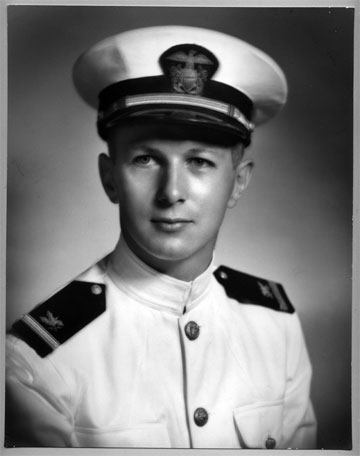 Ensign Robert Wyatt Granston Ensign Robert Wyatt Granston
Sixty-three years later the ex-POW moved next door to the sole surviving crewman of the Enola Gay whose mission Granston credits with saving his life. His poignant experience of life-and-death struggle to survive in prisoner of war camps and hell ships is the opening chapter of My True Course Dutch Van Kirk Northumberland to Hiroshima. Van Kirk's biography is an authentic American story of the home front, in-service, and Special Mission No. 13, the first atomic strike in history. Robert Granston received the Navy Cross for his heroic actions and distinguished service following the bombing of the Cavite Navy Yard on December 10, 1941. In 2009, he donated the Navy Cross to the Supply Corps Museum. Granston does not believe that his actions were anything out of the ordinary and said, "There is no larger word in the English language than �duty.' You can do no more than your duty and you should never do less." Note: Suzanne Simon Dietz is the historian for the Aero Club of Buffalo and the Town of Porter (home of Fort Niagara), New York. She is the author of more than half a dozen historical books including Van Kirk's authorized biography, Honor Thy Fathers & Mothers Niagara Frontier's Legacy of Patriotism and Survival (includes more than a dozen accounts of American POWs held by Germany), and POWs Interned at Fort Niagara A Reference Manual. Her latest publication is Honor Thy Brothers The Fight Against Communism, a collection of veterans' stories from WWII, Korea, and Vietnam. |
Circle of Treason: A CIA Account of Traitor Aldrich Ames and the Men He Betrayed
|
|
Aldrich Ames was a one of the most destructive traitors in American history, and thus, not surprisingly, there are a number of Ames-related books in print, of varying degrees of insightfulness, whether directly focusing on him or featuring particular aspects of his case such as the decades long internecine CIA/FBI conflicts. Circle of Treason's advantage is that it was written by two of the five primarily responsible CIA principals for the Ames "collar," specialists in the clandestine service especially of the Soviet Union. It reflects both their personal and professional viewpoints as co-workers with and then pursuers of Ames, before, during and after the mole hunt including the often noisy backlash that followed at all levels within and without the Company including on The Hill. The Ames story of vast treasonous duplicity may have been often told, but this is an insiders' perspective, with clarifying details and upfront identification of the vicious damages, the sad glories and the assorted "warts" of the case. It provides an extraordinarily detailed discussion of the agents and their secrets betrayed by Ames, with stunning assessments of the devastating losses for all structural and human components. The Circle of Treason provides all that one might expect but also some remarkable surprises. On the one hand, the authors, Grimes and Vertefeuille, both career CIA employees, forthrightly address the innately convoluted path to the CIA's alerting to, eventually identifying and bringing down Aldrich Ames. In that regard, as observed by longtime OSS/CIA veteran operative Betty McIntosh, author of Undercover Girl and Sisterhood of Spies, "is an extraordinary tribute to their training, ingenuity and access to CIA top secret files, Soviet agents collaborating with CIA, FBI colleagues and their own CIA training over 25 years. It took them three years to uncover the CIA mole in their midst. The book is a tribute to their work." Left unsaid is that the two women authors are worthy successors to the spy-crafty primarily historical women about whom McIntosh has written so articulately. That said, perhaps the even more extraordinary contribution made by Circle of Treason is the detailed and utterly unexcelled core access to CIA inner-workings, whether by binder or performance, by departmental organization, job title, name by name, and in some cases, personality versus reputation. One would be hard pressed to read a book that is more convincingly an instructional manual for operational endeavors, taken virtually from file drawer by locked file drawer, safe, vault, drop and safe house. |
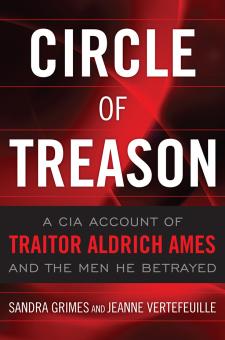
There are so many non-alias names, folks who have long indulged in secure public anonymity that it often reads like an internal CIA phone book; and the detailed discussions of often-complex operational techniques and activities are simply astounding. For whatever reasons, secrecy, from shallow to deep, does not remain a viable entity and the book is a layered labyrinth of fascinating data with or without the specific Ames-related details. It is noteworthy that while the undeniably authentic book is indeed saturated with the authors' own credible authority, stylistically the words sometimes flow more like a thesis than prose with occasional bursts of in-house jargon. Nonetheless, this in no way detracts from the awesome heft of the provocative tale told. The awesome Selected Chronology alone is a significantly illuminated time-line for decades of spy craft. From the outset, it is stated that the revelations are made with the full cooperation of the CIA. The authors themselves raise the issue from page one as to why it is the time for them to air material previously considered classified, and hasten to assure that they do so not as "leakers" but with the Agency's cooperation. After reading their work, it might be surmised that Company positive assistance was not a mere lack of censure. Having met the criteria and demands of the CIA's Publications and Review Board provides prima facie notice of cooperation, but the depth and intricacy of the revelations simply must be seen in print to be believed. Whatever the rationale for the unabashed candor, there is a truism [that has always been known inside Langley but not always in a Hollywood context], "you could not make up this stuff." Indeed Mmes. Grimes and Vertefeuille, did not make it up, but relate it in intimate, excruciating, and spellbinding details, making it all the more extraordinary and worth reading. For poetic classicists, the book title will recall Dante Alighieri's Divine Comedy, wherein Virgil's guidance through the stages of Inferno eventually leads to the 9th Circle of Hell, Treachery, reserved for those who betray those closest to them. Circle of Treason, through the voices of two modern day Beatrices, worthily dissects that special place in Hades as fully earned by the traitor Ames. |
| Bring Bowe Home |
|
They are not fancy folks, Jani and Robert Bergdahl, but a bright, hardworking, solid, unflinching couple, she with piercing brown eyes and straight cut shoulder length brown hair; he with a strong, straight forward look, directed fierce eyes in a ruddy face surrounded by a batch of slightly unruly reddish beard. Someone hands him a bandana emblazoned with POW on the front. He explains that the beard is but a chronology of his son's captivity since June 30, 2009. They look a bit out of place, not uncomfortable but somber and eager. They certainly never expected to be banked on all sides by the strong-hewn, solid look of the black motorcycle leathers of Rolling Thunder, their escort and guard, an impermeable human backdrop to support them as he spoke what he had come all the way to the Vietnam Memorial Wall in Washington to say. 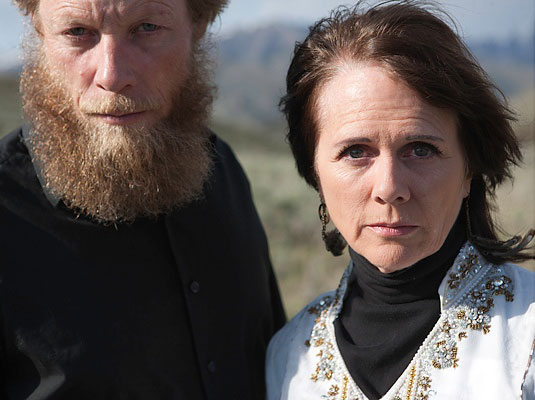 The Bergdahls journeyed from a tiny town in Idaho, Hailey, population 6,000, from whom one precious citizen is currently absent, their now 26 year old son, Bowe. They have not and are not now trying to buck the establishment, one with which they certainly never intended to become buddies, but such intimacy has been thrust upon them by circumstances that everyone would wish to be different. Robert's words are spoken in a strong, convincing manner, and clearly straight from his depths: "Bowe, your family has not forgotten you, your hometown has not forgotten you. Your state of Idaho has not forgotten you, and thanks to all of you here today, Washington, D.C. has not forgotten you." "Bowe" is Bowe Robert Bergdahl, born March 28, 1986 in Sun Valley, ID, and assigned to the 1st Battalion, 501st Infantry Regiment, 4th Cavalry Combat Team, 25th Infantry Division out of Ft. Richardson, AK. The exact details of the circumstances of his capture in Afghanistan's Paktika Province vary but it appears that his captors were a Taliban-affiliated Haqqani group led by senior leader Maulvi (Mullah) Sangin Zadrain (who is shown on one of the videos with him) who then moved him to Ghazni Province. It is publically unclear whether he is now in Afghanistan or Pakistan. The senior Bergdahls are a couple following the spirits and actions of hundreds of families before them, in a handful of wars, simply trying to get their precious family member returned from captivity. Since he was last home, they have seen him on five videos made by his captors, the last one in May 2011 his face showing considerable bruising. Sometime in late August or early September 2011, Bowe purportedly jumped from a first floor window of a mud-brick house in Pakistan where he was then imprisoned and headed for the underbrush and mountains; according to three seemingly reliable militants present at the time, he was recaptured three days later. |
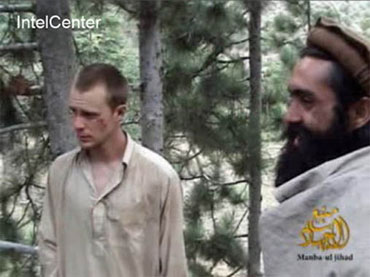
A PFC when seized he has twice since been promoted. The Taliban has in public demanded $1 million and the release of 21 Afghan prisoners and Aafia Siddiqui in exchange for his release. The U.S. Government has readily acknowledged that military and diplomatic efforts including negotiations with Bowe Bergdahl's captors have gone on at a feverish pace for nearly three years, but recently stalled for reasons not entirely clear, partly relating to prisoner exchanges and when the Taliban diplomatic negotiating office in Qatar was suspended in March. To make his situation public was earlier thought by some to enhance the Taliban's negotiating position. But senior Government officials have always strongly expressed their support of his release. The Chairman of the Joint Chiefs of Staff has met with the Bergdahls several times himself as have others. Said one high DoD official: "We want our guy back. Period." And many other former POWs have joined the chorus on Bowe's behalf, including NamPows CAPT Jerry Coffey and CMDR Render Crayton who collectively spent 5,000 days in captivity. During Bowe's nearly 1,000 days in captivity, the family has been in touch with Washington movers and shakers and their support has been mutual. Former POW SEN John McCain confirms that he has been in constant touch with the officials and that Bowe Bergdahl's return is of the highest priority. More recently, the Bergdahls have availed themselves of something not available to those parents who wrote to Berlin in World War II or even the spouses who petitioned the Paris Peace Talks in the 1970's, the internet. They have even e-mailed someone they think has connections with the Taliban to let them know of the continued interest. And for nearly two years, they kept utterly silent while the U.S. government worked to free their son. They broke their silence only to bring focus on the situation, not to lash out at anyone or violate any laws or trust.
We can just hope that it may achieve the ongoing general purpose of placing renewed focus on all POW/MIAs, but specifically, the goal of bringing Bowe home. |
AXPOW Officer Charles Susino Enumerates Veterans' Legislative Priorities to Joint Congressional Committee
March 21 testimony before joint session urges more inclusive health care standards, expanding benefits to veterans left out under current guidelines. |

AXPOW Sr. Vice Commander Charles Susino, Sr. My name is Charles Susino, Sr. Vice Commander of the American Ex-Prisoners of War. I am honored to testify before you again today on behalf of National Commander Carroll Bogard. Senator Murray, Senator Burr, Representative Miller and Representative Filner, I congratulate your efforts as you navigate your committees through the second half of the 112th Congress. Our organization has watched you and your colleagues grapple with hard decisions while attempting to provide for America's veterans, their families and survivors. This year marks the 70th birthday of the American Ex-Prisoners of War. On April 14, 1942, two mothers whose sons had been captured on Bataan formed the Bataan Relief Organization; in 1945, after the POWs returned home, we became the Bataan Veterans Organization; and in 1949, expanding our membership to encompass ALL former prisoners of war from ALL wars, we became the American Ex-Prisoners of War. Since World War I, more than 142,000 Americans - including 85 women - have been captured and interned as POWs. Today, former POWs number just about 15,000. And soon the concerns of our tiny group of heroes will matter not�to this committee or any other. Some of our youngest members are in their early thirties; however instead of 142,000, as in the past, we're talking of just 23 former POWs from current conflicts. We are immensely grateful for past Congressional actions to help ex-POWs. It was our organization who pushed in the early 1980s for "Presumptives" and because of the efforts of your committees, the Veterans Administration and the heroes in red jackets walking the halls of Congress telling the stories of former prisoners of war, we now have benefits and entitlements that protect us... and the POWs that will surely come after we are gone. Gout: no one's sure why you get it, but you'll sure know it when you do.
Gout causes a sudden onset of intense pain and swelling in the joints. Attacks frequently occur at night. To learn more about causes, symptoms and treatment, see the current issue of The Ex-POW Bulletin. Click here to read online. As we look to the future, we want to lend our small voice and support to America's aging veteran population from WWII, Korea and Vietnam � veterans who may have fallen through the cracks of care because of rulings enacted to cope with the frightening possibility of many millions of applicants to the Veterans Administration. 16,112,566 individuals were members of the United States armed forces during World War II. In November 2011, the Department of Veterans Affairs estimated that approximately 1,711,000 American veterans were still living. More than 1,100 WWII veterans die each day. The average age of a WWII veteran is 92. 1,800,000 individuals were members of the United States armed forces serving in Korea during the 3-year period of the Korean War. Only about 1/3 of that number are still alive today. The average age of a Korean War veteran is 85. 2,594,000 individuals served in South Vietnam Jan. 1, 1965 - Mar. 28, 1973. Of this number of Americans who served in Vietnam, less than 850,000 are estimated to be alive today. The average age of a Vietnam veteran is 66. These are our "youngsters" in the time frame I'm speaking on today. The clock is ticking and time is running out for the brave men and women who fought the good fight to keep America free. And while the debt we owe them can never be repaid in full, you can make their next days, months, years better. There are less than 3 million heroes alive from these three great conflicts. You could fit them all into the city of Chicago. As they have aged, their disabilities have left many of them with poor quality of life and financially burdened. Many of these Wartime Veterans are in the VA Category 8 or lower, which means they are not entitled to VA care at all. These Veterans are designated as Priority 8 when their income exceeds a pre-set threshold classifying them as "affluent." They are the most affluent category of vets, yet some earn as little as $28,430 a year � hardly affluent. A significant change was made in health-care eligibility in 1986. Congress mandated VA health care for veterans with service-connected disabilities as well as other special groups of veterans, such as former prisoners of war, veterans exposed to herbicides and ionizing radiation and veterans of World War I. The average age of the WWI veterans was 88 in 1986�younger than today's WWII veteran; virtually the same age as today's Korean War veteran. Today, we have a request of you, the 112th Congress: please update the 1986 law to add WWII, Korean, and Vietnam War veterans to this special group of veterans to make them eligible for health care. Please also consider including the Gulf War veterans in this special group as well. It is overdue to update Congress' actions in 1986. From a health benefits standpoint, this puts these war-time veterans on par with WWI veterans, the special groups, and the current warriors who are fighting in the middle-east, all of which we strongly support. Please let them not be forgotten. Please do not continue to allow these war time veterans to be excluded and deprived health benefits. It's the right time to add these heroes to this special group of veterans. It's the right thing to do. We are willing and able to work with you or your staff on drafting this amendment. We would also like to join our brother veteran service organizations in asking your consideration of the following bills: HR 813, introduced by Representative Bob Filner (CA), which would amend section 1318(b)(1), title 38, United States Code, to allow dependency and indemnity compensation (DIC) to be paid to the survivor of a veteran whose was continuously rated totally disabled for at least one (1) year immediately preceding death, whereas, eligibility under current law requires the veteran to be rated totally disabled for a minimum of ten (10) years. S423 introduced by Richard Burr (NC). Authorizes the Secretary of Veterans Affairs (VA) to provide an effective date of an award of disability compensation, in the case of a veteran who submits a fully-developed claim, of up to one year before the date of receipt of such claim. HR28 introduced by Mike McIntyre (NC). Veterans Outreach Improvement Act of 2011. A bill to amend title 38, United States Code, to improve the outreach activities of the Department of Veterans Affairs, and for other purposes. HR23 introduced by Bob Filner (CA) Belated Thank You to the Merchant Mariners of World War II Act of 2011. A bill to amend title 38, United States Code, to direct the Secretary of Veterans Affairs to establish the Merchant Mariner Equity Compensation Fund to provide benefits to certain individuals who served in the United States merchant marine (including the Army Transport Service and the Naval Transport Service) during World War II. HR178/ S.260 introduced by Joe Wilson (SC)/Bill Nelson (FL). Military Surviving Spouses Equity Act. A bill to amend title 10, United States Code, to repeal the requirement for reduction of survivor annuities under the Survivor Benefit Plan for military surviving spouses to offset the receipt of veterans dependency and indemnity compensation. HR309 introduced by John Mica (FL). Samuel B. Moody Bataan Death March Compensation Act. A bill to provide compensation for certain World War II veterans who survived the Bataan Death March and were held as prisoners of war by the Japanese. HR303 introduced by Gus Bilirakis (FL). Retired Pay Restoration Act. A bill to amend title 10, United States Code, to permit additional retired members of the Armed Forces who have a service-connected disability to receive both disability compensation from the Department of Veterans Affairs for their disability and either retired pay by reason of their years of military service or Combat-Related Special Compensation and to eliminate the phase-in period under current law with respect to such concurrent receipt. HR812 introduced by Bob Filner (CA). Agent Orange Equity Act of 2011. A bill to amend title 38, United States Code, to clarify presumptions relating to the exposure of certain veterans who served in the vicinity of the Republic of Vietnam. HR3712 introduced by Martin Heinrich (NM). Bataan Defenders Congressional Gold Medal. A bill to grant the Congressional Gold Medal to the troops who defended Bataan during World War II. The American Ex-Prisoners of War are proud supporters of The Independent Budget. The FY2013 edition represents the 26th consecutive year that our partnership of veterans service organizations has joined together to produce a comprehensive budget document that highlights the needs of every generation of veterans. During that time, The Independent Budget has improved signifi�cantly while gaining much more respect and recognition. Messrs. Chairmen and Committeemen, this completes my testimony. Thank you for allowing me the opportunity to appear before you on behalf of the American Ex-Prisoners of War to share our goals for the 112th Congress. Thank you also for all that your Committees have done and for all that you will do for our nation's veterans and their families in the future. God bless America. March 21, 2012
Joint Hearing: Legislative Presentation of the Military Order of the Purple Heart, IAVA, Non Commissioned Officers Association, American Ex-Prisoners of War, Vietnam Veterans of America, Wounded Warrior Project, National Association of State Directors of Veterans Affairs, and The Retired Enlisted Association |
| The Buckles Family, Revisited |
| by Alice A. Booher
Frank W. Buckles, the last surviving American WWI veteran, died on February 27, 2011, at age 110. During the war, he drove Army ambulances and motorcycles, guarded German POWs and then escorted them as they returned home at war's end. In WWII, while working with White Star Line in Manila, Buckles was taken prisoner by the Japanese for 3 years, 2 months. He was interned at Santo Tomas, where he planted a vegetable garden, helped with therapeutic exercises for a polio victim and tended other POWS. Buckles pursued neither recognition nor even veterans' benefits after WWI, but following WWII he used VA educational benefits at business school and lVA medical benefits later in life, including for hearing aids. Buckles was a staunch advocate for veterans was National Commander of the Veterans of WWI, and he was an active supporter of its publication, The Torch. He was an articulate, erudite man who read classics in their original Greek and Latin. He rode his John Deere tractor on his 320-acre farm, into his late 90's. The farm, which had been in his family since 1732, stood in Charlestown, WV, overlooking the Civil War battle sites of Antietam and Harper's Ferry. AMD Doesn't Hurt; It Just Takes Your Sight.
Age-related macular degeneration is a leading cause of vision loss in Americans over 60. What are its origins? Is it treatable? Learn about the symptoms and detection. See the current issue of The EX-POW Bulletin. Click here to read online. In his last few years, the national press featured his regular participation in Veterans Day activities at Arlington National Cemetery, with pictures of him in his Army long coat, cap at a jaunty angle with wool scarf and wooden wheelchair, usually near GEN Pershing's grave. On one such visit to Washington, D.C., Buckles was driven past, and took notice of, the local D.C. WWI memorial, then a rather seedy-looking edifice hidden in brambles at the back of the Mall off Constitution Avenue. The memorial had been dedicated on November 11, 1931 by President Herbert Hoover, GEN John J. Pershing and band leader John Philip Sousa. It is a domed, wedding cake-shaped affair, 47 feet tall, small, white and round with Jefferson Memorial-like columns. It had been paid for by locals to honor residents of the District who had served and died (1914-1918). Through persistent ongoing attention and by capitalizing on the otherwise unwanted personal publicity that came from his visits, Buckles was able to make the case that the site might be suitable as a WWI National Memorial. |
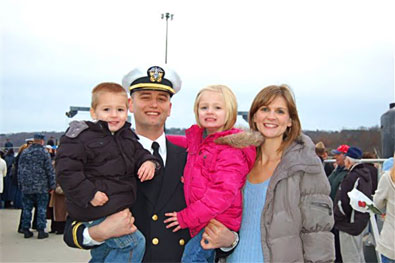
The latest Buckles in uniform: Navy LT Robert Buckles, assigned to Naval Submarine Learning Center, Naval Submarine Base New London, poses with his family after returning from a deployment while assigned to the USS Miami in 2009. Pictured with Buckles are his son Charlie, his daughter Grace, and wife Katrina.
At the very least it should be cleaned up, he suggested, calling attention to the broken fieldstone pathways, cracked marble and overgrown scrubs and lawn. A Foundation was set up and effectuated renewal, using some Federal stimulus money and donations. The site was rededicated on November 11, 2011 and is now cared for by the National Park Service. Frank Buckles' idea to make it a National memorial met some opposition from the DC folks who bristled at home rule issues (other options might be Pershing Park in downtown D.C.). Nonetheless, Buckles made his point and, even at age 109, continued to make a difference. With Frank Buckles, death, when he was honored by President Obama and other national leaders, the legacy of the family name is now carried on at the Naval Submarine Base in New London, Connecticut where a young Navy LT, Robert Buckles, is assigned. His own military inspiration comes as well from an uncle, Army Captain Richard L. Buckles, who died in Vietnam in 1969, (earning the Purple Heart and Silver Star trying to save a comrade). LT Robert Buckles is related to Frank W. Buckles through a family lineage dating back to 1719. In that year, the first Buckles to arrive in the United States was also named Robert, son of a wealthy English landlord, who left England on a vessel headed for the land of promise. (With the crew's help, he traveled as a stowaway, hiding from authorities in a barrel of sand.) Since then, genealogical research shows Buckles relatives serving in the Revolutionary War, the Civil War, WWI and WWII, the Korean War, Vietnam as well as present day conflicts. One Milton Abraham Buckles fought in the Civil War and left diaries of his service. With six months remaining on his enlistment, Milton's diary entry for February 15, 1865, noted: "We have high hopes of seeing home, and the loved ones who have so long patiently endured trial and hardship for ours and their country's sake. We have endured and suffered more during the time we have been in the war, but no man now regrets what has passed, but all are glad to have done something for their country." Clearly Milton Buckles spoke eloquently for an extended family of patriotic veterans that over generations has been quietly building a tradition of an inspiring American legacy. |
| Copyright © 2013. All rights reserved. The documents on this site are owned by the American Ex-Prisoners of War. Copying any materials on this site is expressly forbidden without the organization's express written permission in individual instances. Republication is forbidden in order to avoid the creation of adulterated or obsolete versions, as well as unauthorized commercial exploitation. |

 "This symbol of our nation's gratitude on the Capitol Grounds will underscore our commitment to American service members still missing and provide a measure of solace to the families of our nation's heroes who have also made extraordinary sacrifices."
"This symbol of our nation's gratitude on the Capitol Grounds will underscore our commitment to American service members still missing and provide a measure of solace to the families of our nation's heroes who have also made extraordinary sacrifices."
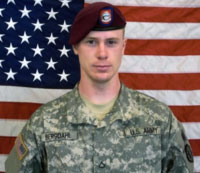 By all accounts, Bowe Bergdahl himself is a remarkable and very interesting young man. But that is a story for another day. For anyone who has dealt with and appreciated the sustained passion of Rolling Thunder and others who work and care on a daily basis for POW/MIA's, the Memorial Day tribute and special focus was all about grassroots awareness, a very real, raw love and a visceral, positive moving representation of American patriotism.
By all accounts, Bowe Bergdahl himself is a remarkable and very interesting young man. But that is a story for another day. For anyone who has dealt with and appreciated the sustained passion of Rolling Thunder and others who work and care on a daily basis for POW/MIA's, the Memorial Day tribute and special focus was all about grassroots awareness, a very real, raw love and a visceral, positive moving representation of American patriotism.